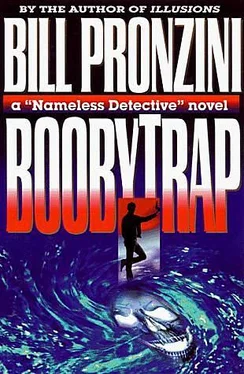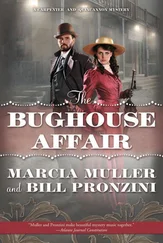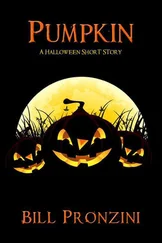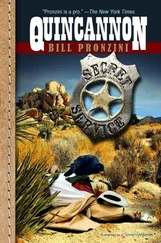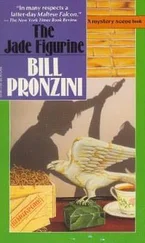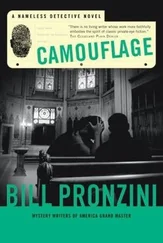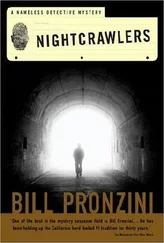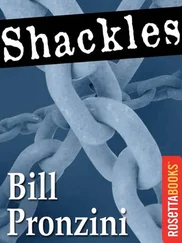Option number three: Find a way to lure Dixon up here immediately. Fake emergency, something like that. Tricky. I can’t think of anything that would bring him running without also making him suspicious when he finds out there’s no emergency after all. Once he’s here he has to have his mind on R&R, nothing else, otherwise the device doesn’t get triggered. Bad idea. Scratch that one. When the bastard comes he has to come on his own hook. Hah!
The second option is the one that makes the most sense. Leave the package where it is, wait it out, trust that nobody but Dixon gets a faceful of hell. The longer the anticipation, the sweeter the revenge.
The road that led around the east end of the lake into the wilderness was narrow, heavily pitted in some places, rock-strewn in others. My old car wasn’t right for it; I had to do some fancy maneuvering to keep from tearing up the undercarriage, maybe puncturing the oil pan and stranding myself out there. Three miles in, the track was so narrow and tree-hemmed that an oncoming vehicle of any kind would’ve created a two-car gridlock.
I bumped around a sharp left-hand turn and finally emerged into a small grassy glade. According to Judson’s map, this was as far as you could drive. It surprised me a little to see a beat-up, ten-year-old Chrysler LeBaron and a Chevy four-by-four already parked there. I’d left the cabin at first light, and the sky was still pale and the shadows long and deep under the pines. So much for the idea of stealing a march on anybody else who might be headed for Two Creek Bar.
I slanted in next to the four-by-four and popped the trunk lid. Preparations first. I was wearing a thin cotton shirt under a heavy wool Pendleton that I could strip off when the day warmed, heavy cord pants with my fish knife sheathed at the belt, the high-topped work shoes, and my old slouch hat; I added a lightweight canvas creel on a strap slung over my shoulder, then buttoned a couple of nutrition bars into one shirt pocket and a flat plastic case into the other. The case held six lures — nothing fancy this first time out, just a pair of Royal Coachmans, a pair of Light Cahills — #12 and #14 — and a Gray Hackle and a Spider. When you fish mountain streams, particularly ones you’ve never seen in unfamiliar territory, you’re well advised to keep one hand free to help you move from rock to rock, around trees and other obstacles. And the fewer items you have attached to your clothing, the better the odds against snags and torn fabric.
The bamboo rod and Daiwa reel came out next. I’d already rigged a leader and hook to the .009 monofilament line, tied off with a blood knot; I made certain the reel’s bail was thumbed-down tight and then hefted the rod, made a few practice flips to test its resiliency. It felt fine in my hand. Some of the old sportsman’s excitement began to work in me. I’d almost forgotten how much pleasure a man could derive from being out in the woods like this, on his way to a trout pool.
Two deer trails led off at angles from the glade, like spokes from the hub of a wheel. The one to the northwest was the way to Two Creek Bar. I set out along there, through ferny underbrush, walking carefully and watching the tip of the rod. Break your favorite rod the first day out and you might as well quit and go home because you’re in for miserable luck. Fisherman’s superstition, one I’d never argue with.
The trail led gradually, then more steeply, up to higher ground. The first half to two-thirds of a mile was through dense forest, mostly lodgepole and tall, straight sugar pine; after that the trees thinned and the terrain opened up into a long, sloping meadow spotted with boulders and outcrops. Yellowed grass, dusty and pungent, with a deadfall at one end. High fire danger here. But this country was loaded with deadfalls and tinder-dry grass and brush. Every summer would be just a little nerve-wracking for anyone who lived in the more remote sections of the Sierras.
I quartered downslope to the west. Birds chattered now and then; otherwise, the morning held an almost preternatural hush. The sun had bobbed up now, its light dazzling on the distant peaks, a rich mellow gold on the meadow grass and across the tops of the pines at higher elevations. The air was thin and sweet and cold. It burned in my lungs, had me panting even though I was not setting much of a pace. Come on, fats. Nils Ostergaard’s got twenty years on you and he could probably hike five times as far without breaking a sweat. The thought kept me plodding onward instead of taking a rest stop.
The ground continued to slope downward, through more woods. I heard the stream before I saw it, the good icy rush of water tumbling over rocks. Another fifty yards and the first silvery flashes appeared among the shadows; another fifty after that and I was out onto its bank, grinning at the stream as if it were Dr. Livingstone and I was Mr. Stanley.
Twenty feet wide at this point, the stream was clear and shallow and fast-moving. And clean, literally above pollution. Still grinning, I headed upstream with the creek’s voice in my ears. Trees and undergrowth clogged the bank in places, so that I had to wade through the chill water. For the most part, though, it was an easy hike, past small pools and riffles, shallows and eddies, flats and glides.
At the end of a quarter mile the creek hooked left, and when I came around the bend I was looking at a wide, deepish pool. Above it, on higher ground where runty digger pine grew, a second creek, quick and narrow, joined this one from the east; at the juncture there was a curling gravel bar that had given the spot its name. Sunlight glinted off bits and pieces of mica rock along the bar. I wondered if maybe there were flakes of gold there, too, washed down from the higher elevations. Gold collected in such bars, sometimes in quantities large enough for backcountry prospectors to eke out a living. Not here, though, or the spot wouldn’t be on Mack Judson’s map. Gold hunters are considerably more jealous of their favorite haunts than fishermen are of theirs.
I waded out to a flat rock at the pool’s edge, squinting against quicksilver flashes coming off the surface, and hunkered down to peer into the depths. Clear all the way to the bottom, three feet or so here and likely deeper in the middle. Trout in there, all right, even though I couldn’t see them. You can feel their presence in pools like this one, shadows moving among other shadows beneath the light.
I took out the lure case. The Gray Hackle struck me as my best bet in water like this, with the air as still as it was; I tied it on and made my first cast, downstream toward where a lopsided pine jutted out from the far bank. It didn’t get me anything, so I reeled in and made another cast, this time dropping the fly in the pool’s center. I drew it along about a foot below the surface, slowly, letting the water give it plenty of sideways twitch and sway. Nothing. I tried again, a little farther down and to the left of the canted pine.
Small tug on the line as I reeled in, then another, harder bump. I snapped the tip of the rod upward, striking against the bite. The rod jerked and shimmied in my hand. In the next second I saw the fish just under the surface, a darkish movement coming my way, and then he was out, hanging and twisting, his square tail slapping the water so hard spray went flying halfway down the pool.
Oh, man, he was a beauty. A big cutthroat, eighteen or nineteen inches long and at least two pounds, maybe as much as three — a brilliant orange and brightly speckled, with a bullet head and a broad tail.
Gone again, then, and the rod bent and the reel made a ratchety buzzing noise before I could snub the line. He was heading for a stony riffle at the far end of the pool. I hauled on the rod, got him turned; he jumped again, arching, throwing spray. But he was hooked good. The rest of the struggle was brief, almost anticlimactic.
Читать дальше
